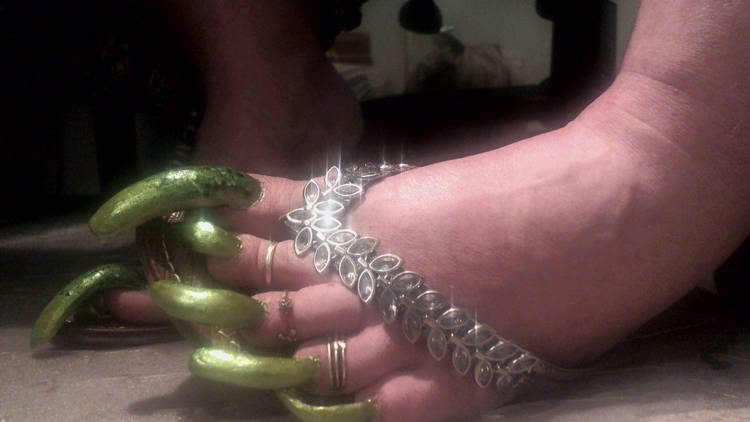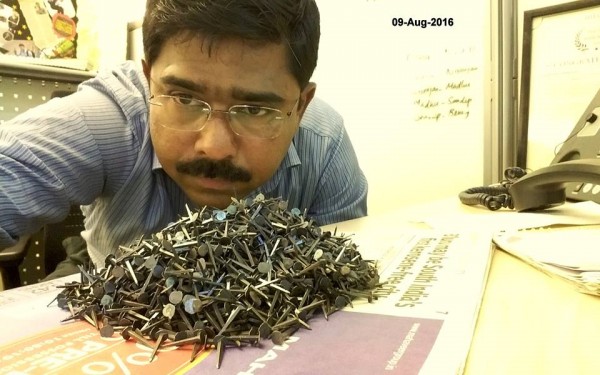Woman Makes a Living Selling Videos of Her Painfully Long Toenails

Most of us have to trim our toenails as soon as they become even slightly uncomfortable, but for “long nail beauties” like Arinda Storm Weaver that’s not an option, as their nails are the objects of desire for thousands of people around the world, and a valuable source of income. The 58-year-old from Ohio used […]
Indian Engineer Spends the Last Five Years Collecting over 50 Kilograms of Nails from City Road

Benedict Jebakumar is a man on a mission. Ever since 2012 he has dedicated his free time to sweeping Bangalore’s Outer Ring Road of metal nails deliberately put there by nearby tire puncture shops to boost their profits. In the last five years, the Indian engineer claims to have collected over 50 kilograms of metal […]
David Foster’s Amazing Hammered-Nail Portraits

Who would have ever thought that fine art could be created out of something as crude as a hammer and a bunch of nails? I’ve seen several art forms made using Pointillism before, but former architect David Foster’s work is quite unique. At first glance, it’s hard to believe that his breathtaking portraits were once […]
Stunning Portraits Made with a Single Sewing Thread Wrapped through Nails

Japanese artist Kumi Yamashita creates mind-boggling portraits by wrapping a single UNBROKEN black thread around galvanized nails, on a clear white board. In the four years since I started Oddity Central, I’ve had the opportunity of discovering many great artists. Most of their works are nothing short of impressive, but there are a few whose artistic genius […]
Design Duo Create Mind-Blowing Thread and Nail Portraits

Pamela Campagna and husband Thomas Scheiderbauer create intricate thread and nail portraits based on old family photographs. It’s amazing how someone can recreate organic shapes so well from thousands of angles created with nails and thread. Designers Pamela Campagna and Thomas Scheiderbauer take up to a month to work on each of their complicated artworks, […]
Taiwanese Artist Uses Nail Gun as His Brush

Artist Chen Chun-hao, known as Howard Chen in the western world, uses a nail gun, an air compressor and millions of small nails to create incredible works of art. Chen isn’t the only artist in the world using nails to create impressive artworks. Marcus Levine is perhaps the most famous nail-using person in the art […]
Marcus Levine’s Hammered Nail Art

Using up to 50,000 rigid steel nails to recreate something as fragile and curvy as the human body isn’t the easiest of tasks, but artist Marcus Levine manages to to it without as much as a sketch. The British artist’s road to his brilliant career has been anything but predictable. Born in Yorkshire, Levine attended […]
Pixelated Self-Portrait Is Made from Over 10,000 Nails and Screws

Inspired by the work of mosaic art masters like Saimir Strati, artist Shannon Larratt has created a unique self-portrait from thousands of different nails and screws. Shannon used a four foot sheet of heavy 3/4″ plywood as canvas and six different kinds of nails and screws space roughly 5/16″ apart. He estimates there are around […]
Nailympics – The Olympic Games of Fake Nails

Every year, teams from various countries around the world gather in Britain to compete in the Nailympics – the ultimate fake nail showdown. For the last six years, the world’s top manicutists have been coming to Britain to show their skill in the art of fake nail making. Everyone knows everyone, but because of the […]
Human Ivory Jewelry Is Pretty Original

Rachel Betty Case uses finger and toe nail clippings to create cool jewelry she refers to as Human Ivory. The artist acknowledges nails are neither bones nor teeth, but that hasn’t stopped her from comparing them to precious ivory. She uses clipped nails, resin and amber to create bizarre unisex jewelry that make perfect gifts […]
